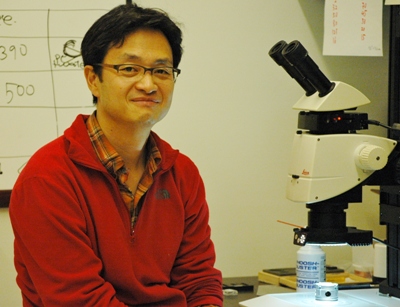Nov 27 2013
The center of the Earth is about 6,371 kilometers or 4, 000 miles away, roughly the distance between Phoenix and the North Pole.
 Sang-Heon Dan Shim, a mineral physicist in the School of Earth and Space Exploration, uses a microscope and needles to place tiny rock samples in between two diamonds. Shim uses the diamonds to simulate conditions that exist in the Earth's interior. (photo by: Kristen Hwang)
Sang-Heon Dan Shim, a mineral physicist in the School of Earth and Space Exploration, uses a microscope and needles to place tiny rock samples in between two diamonds. Shim uses the diamonds to simulate conditions that exist in the Earth's interior. (photo by: Kristen Hwang)
It cannot be seen. It cannot be touched. And it cannot be sampled.
But that doesn’t stop Dan Shim, a mineral physicist in the School of Earth and Space Exploration at ASU, from trying to understand the forces working deep within our world.
“You may wonder why I’m interested in the interior, which is far, far away and sounds like something that is separated from our daily life,” Shim said. “But if you think of the whole planet, the surface is very small volumetrically and the interior represents 99 percent of the planet.”
Studying the interior of the Earth helps scientists answer questions about how the Earth has changed over billions of years and why there are volcanoes and earthquakes, Shim said.
But figuring out what the inside of the Earth is made of is not so easy.
“If you think about geologists, you think about rocks and studying rocks, but in our case there are no rock samples to deal with unfortunately,” Shim said.
There are several different ways to study the Earth’s interior, which cannot be directly probed. Seismologists look at how earthquakes propagate through the Earth and try to construct an image based on the waves’ reflections and refractions.
Shim’s research helps seismologists understand what the images mean.
“If you do an ultrasound of your body, you’re basically looking at contrasts in properties,” Shim said. The reason doctors can say, “This is a tumor,” is because the tumor looks different relative to the image of the body surrounding it, he said.
“But to understand the image, you need to understand the properties of the material that makes up the particular thing you image,” Shim said. “My job is to squeeze the rock up to the pressure you expect for the mantle and the core and observe what kind of processes are going on in the lab.”
Shim and his research team study how the properties of rocks change under extreme pressure and temperature by simulating the conditions in the laboratory.
The laboratory experiments help Shim understand how the deep interior of the Earth operates and helps him interpret seismology data.
“One fancy part of my research is using diamonds,” Shim said.
Diamond is the strongest material known in nature, making it ideal for high pressure experiments.
Using a microscope and a needle, Shim takes pieces of rocks smaller than the width of a human hair and places them in between two quarter-carat diamonds. The diamonds, which are embedded in steel casings, are forced together by four screws to higher and higher pressures.
“If you stack 100 Statue of Liberties, and then apply that weight to one square inch, that’s roughly the pressure at the center of the Earth,” Shim said.
The pressure Shim works with is so great that sometimes the diamonds break, he said.
“We have a joke in my community: How many diamonds do you need to break to get a Ph.D.?” Shim said. “I broke 11.”
Shim has been an associate professor in the School of Earth and Space Exploration since August 2011. He has taught Geology 101, Planetary Materials and will be teaching Dynamic Planet in the spring.
“SESE has a very unique structure bringing astrophysicists, geologists, geophysicists and system engineers all together,” Shim said. “This unique structure presents a lot of new opportunities.”